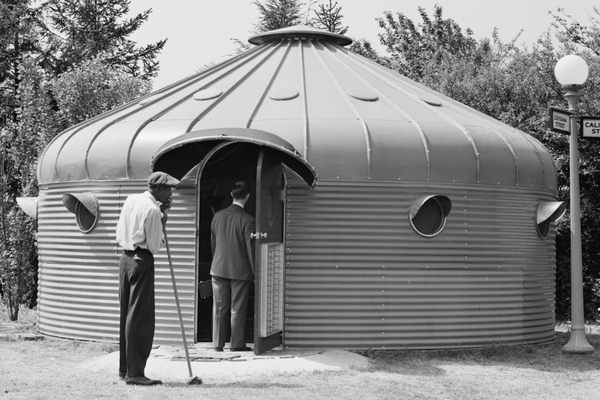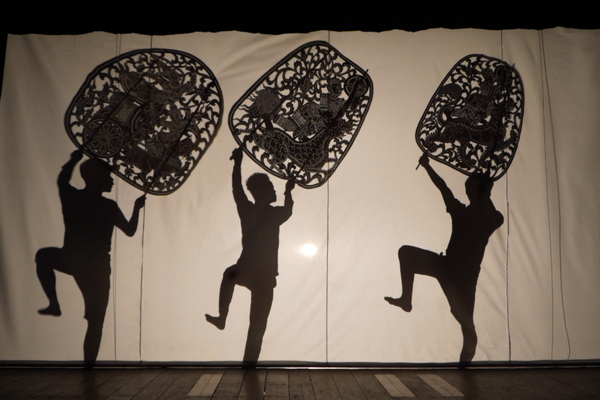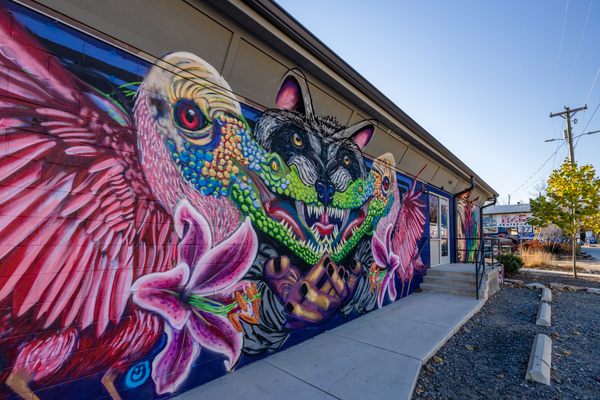
10 Bathrooms to Pee in Before You Die
From a floating restroom to a john encased in one-way glass, these toilets take using the facilities to a whole new level.
Welcome to Where to Wander, our selection of the best under-the-radar destinations in 2025. To see more surprising sites around the world that have fewer tourists and more locals, check out all of Atlas Obscura’s favorite places to travel this year.
The vast majority of toilets around the globe are utilitarian at best—unadorned spaces to get in and out of as fast as possible. Yet some rare standouts go above and beyond answering Nature’s call. Imagine doing your business in a public square while watching passersby through one-way glass in Texas or in a hidden, subterranean Art Nouveau gem in Paris. Some toilets in Australia and New Zealand are literally public works of art, while a pair in Massachusetts are part of a museum’s permanent collection.

Toilet in Nature, Japan
M is renowned for its superior toilets. Where else do airport stalls feature state-of-the-art, butt-warming technology and built-in bidets? But the women’s restroom at Itabu Station, Chiba Prefecture, distinguishes itself in more of a low-tech fashion. This public art installation bills itself as “the world’s largest bathroom stall.” Officially titled Toilet in Nature, the restroom, created by famed Japanese architect Sou Fujimoto in 2012, quickly pushed this small, unattended train station to nationwide notoriety.
Glass Bathrooms of Sulphur Springs, United States
Constructed in 2012 to vie for the title of “America’s Best Restroom,” these are the first restrooms in the United States to be made entirely of one-way glass. They sit along the edge of Celebration Plaza in the middle of downtown Sulphur Springs. The ceiling of each privy, also made of one-way mirror glass, allows it to be illuminated by the Texas sun during the day. At night, an LED array around the base of the structure ensures that it stays reflective and private.
Matakana Toilets, New Zealand
Designed by Matakana lad Steffan de Haan, the Matakana Toilets are a bold artistic take on an otherwise ordinary public facility that pays homage to the significance of boat building to the region. Expect to see plenty of tourists snapping photos in front of these masterful WCs, which took seven years and $400,000 to produce. Each resembles a human face, with echoes of the curved hulls of ships.

Kjærlighetskarusellen (The Carousel of Love), Norway
Since 2009, this public urinal in Stensparken in Oslo has been considered a Norwegian Cultural Heritage Site for its place in local LGBTQ+ history. Since it first opened in 1937, the urinal has gone by a litany of nicknames: “Carousel of Love” (or Kjærlighetskarusellen in Norwegian), the “Wheel of Fortune,” the “Round Barrel,” “the Mushroom,” and the “Umbrella.” In the decades before Norway decriminalized homosexuality, this particular loo was a gathering place for queer men. In 2022, artist Per Barclay initiated the restoration of this unusual historic icon and incorporated colorful lighting into the design.
Hundertwasser Toilets, New Zealand
World-famous artist Friedensreich Hundertwasser’s final project was a set of public toilets in the small New Zealand town of Kawakawa, where he spent his final years—and those toilets are still open for “business.” Covered in the artist’s signature multicolored-tile collages and undulating lines, the toilets resemble his other architectural works in miniature. The facilities opened in 1999, welcoming waves of art lovers who wanted not just to relieve themselves but also record the experience. Recycled bottles and tiles are embedded in the concrete of the facilities to create the psychedelic designs. The center of the restroom has a living tree that grows up through the roof of the pavilion and blends with the native grasses that are grown on the roof.

S.S. Relief, United States
California is home to more than 100 active floating lavatories, each designed to keep sailors from having to dock in order to relieve themselves. The S.S. Relief was installed in 1991 for $50,000 by the Casitas Municipal Water district so that they could drop anchor and use the facilities at their convenience. While swimming in the water reservoir is not permitted, visitors are more than welcome to kayak their way to the two airline-style johns.
Lavatory de La Madeleine, France
Visitors to the Place de la Madeleine in Paris’s 8th arrondissement tend to head straight for the famed Church of Sainte-Marie-Madeleine. Yet tucked away behind an unassuming, wrought iron–fenced area lies another, less-appreciated architectural marvel. The Lavatory de La Madeleine, a designated historic monument, is a public restroom that dates back to 1905. At the time, it was considered unseemly to place a toilet next to a church, so the authorities hid it underground. Walking into this Art Nouveau loo, however, one wonders why anyone would want to keep it out of sight. Warm mahogany, pristine stained glass, and tile mosaics all add to the Belle Époque ambiance.
Minquiers Toilet, Jersey
Somewhere on a group of rocks nine miles south of Jersey, the largest of the Channel Islands, there is a cluster of smaller islands—some would also argue, large rocks—known as the Minquiers. Somewhere on the largest of these islands stands a small shack that has the unique distinction of being the southernmost toilet in the British Isles. When you do your business here, you make history.

Canistrum Toilets, Australia
Designer Michael Lennie described these striking public toilets as “an unfinished basket reflecting an unfinished history.” His concept, which is inspired by traditional Aboriginal basket weaving, was chosen from nearly 200 entries in a competition. Not only are these toilets visually impressive, but they’re also engineered to withstand seasonal flooding from the nearby Mary River.
Mick Jagger’s Urinal, United States
Established in 1885, the oldest bar in San Diego’s Gaslamp District has seen some serious history—not to mention a few rock n’ roll legends. In the gender-neutral restroom, a golden plaque declares proudly: “Mick Jagger of the Rolling Stones used this urinal at the time of their concert at Petco Park 11/11/2005.” Said enshrined urinal is ringed in a set of Kali-esque red lips and often has a second sign asking guests to please respect where the frontman did his business.







































Follow us on Twitter to get the latest on the world's hidden wonders.
Like us on Facebook to get the latest on the world's hidden wonders.
Follow us on Twitter Like us on Facebook